
- ChatGPT - Home
- ChatGPT - Fundamentals
- ChatGPT - Getting Started
- ChatGPT - How It Works
- ChatGPT - Prompts
- ChatGPT - Competitors
- ChatGPT - For Content Creation
- ChatGPT - For Marketing
- ChatGPT - For Job Seekers
- ChatGPT - For Code Writing
- ChatGPT - For SEO
- ChatGPT - For Business
- ChatGPT - Machine Learning
- ChatGPT - Generative AI
- ChatGPT - Build a Chatbot
- ChatGPT - Plugin
- ChatGPT - GPT-4o (Omni)
- ChatGPT in Excel
- ChatGPT for Test Automation
- ChatGPT on Android
- Make Money with ChatGPT
- ChatGPT for UI/UX Designers
- ChatGPT for Web Developers
- ChatGPT for Data Scientists
- ChatGPT for Bloggers
- ChatGPT for Personal Finance Management
- Automate Customer Support with ChatGPT
- Create Content Calendars with ChatGPT
- Plan Events and Trips with ChatGPT
- Draft Legal Documents with ChatGPT
- Improve Your Coding Skills with ChatGPT
- New Language with ChatGPT
- Optimize ChatGPT Responses for Better Accuracy
- ChatGPT Useful Resources
- ChatGPT - Quick Guide
- ChatGPT - Useful Resources
- ChatGPT - Discussion
ChatGPT for Data Scientists
Data scientists can utilize ChatGPT as a valuable AI resource to help with a range of tasks, such as data preprocessing, performing exploratory data analysis (EDA), creating features, building machine learning models, and troubleshooting code. This tutorial offers a detailed guide on how they can improve their workflow by effectively using ChatGPT.
Why Use ChatGPT in Data Science?
ChatGPT can be used in Data Science to −
- Speed up development time
- Enhance code documentation
- Provide quick solutions for debugging
- Suggest feature engineering techniques
- Help in model evaluation and optimization
Prerequisites
Before you begin, make sure you have the following requirements in place:
- Familiarity with Python and data science libraries such as Pandas, NumPy, Scikit-learn, and Matplotlib.
- An account on ChatGPT, which you can access at chat.openai.com.
- A Jupyter Notebook or any Python IDE, such as VS Code or PyCharm.
- A dataset to use, such as the Titanic dataset available on Kaggle.
Data Pre-processing with ChatGPT
Cleaning the Dataset − You can use ChatGPT to write Python scripts that clean datasets. For instance, if you have a dataset with missing values and need to handle them, you can ask the following question −
Prompt: How can I handle missing values in a Pandas DataFrame?

Removing Duplicates − ChatGPT can help you write Python codes to remove duplicate entries from a dataset −
Prompt: How can I remove duplicate rows in a Pandas DataFrame?

Exploratory Data Analysis (EDA) using ChatGPT
Generating Summary Statistics − Use the following prompt to find out the Python code to generate a summary of a given dataset −
Prompt: How do I get an overview of my dataset in Pandas?

Data Visualization − ChatGPT can help generate code for visualizing data using Matplotlib and Seaborn.
Prompt: Can you generate a pairplot using Seaborn?

Feature Engineering with ChatGPT
Creating New Features − ChatGPT can help data scientists create new features in existing datasets −
Prompt: How can I create a new column based on existing ones in Pandas?

Encoding Categorical Variables − Use the following prompt −
Prompt: How do I convert categorical columns into numerical format?

Building a Machine Learning Model
Splitting Data into Training and Testing Sets − Use the following prompt −
Prompt: How do I split my dataset into training and testing sets?

Training a Machine Learning Model − Use the following prompt −
Prompt: Can you provide code for training a Random Forest classifier?

Model Evaluation and Optimization using ChatGPT
Evaluating Model Performance − Use the following prompt −
Prompt: How do I generate a classification report in Scikit-learn?

Hyperparameter Tuning − Use the following prompt −
Prompt: Can you suggest a method to tune hyperparameters for a Random Forest model?

Debugging Code with ChatGPT
If you encounter errors in your code, you can copy and paste the error message into ChatGPT and ask ChatGPT for debugging help.
Prompt: I am getting a KeyError when selecting a column in Pandas. How do I fix it?

Automating Workflows with ChatGPT
You can use ChatGPT to automate repetitive tasks such as cleaning data, training models, and generating reports with scripts.
Prompt: How can I automate data preprocessing and model training in a Python script?

Conclusion
Data scientists can use ChatGPT in several different ways such as data preprocessing, EDA, feature engineering, model building, debugging, and automation. By incorporating ChatGPT into their workflow, they can save time, improve accuracy, and streamline complex tasks.
Start experimenting with ChatGPT today to optimize your data science workflow!